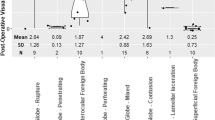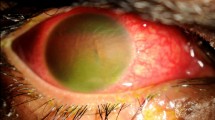Abstract
Purpose
To assess the number of recruits for military service in the Israeli Defense Force (IDF) who underwent refractive surgery prior to enlistment and examine whether the procedure affected their ability to accomplish combat training.
Setting
Medical records of IDF recruits.
Design
Retrospective analysis of medical records of recruits with ametropia who underwent or did not undergo refractive surgery prior to enlistment.
Methods
Recruits were categorized into ametropes and recruits who underwent refractive surgery. Fitness and assignment to combat units and completion status of combat training were compared between the two groups.
Results
The study included 334,688 (182,969 males, 151,719 females) ametropes of which 5231 (4753 males, 478 females) underwent refractive surgery prior to recruitment. Refractive surgery prevalence increased from 9/1000 ametropes in 2005 to 18.5/1000 ametropes in 2018 (r = 0.912, p < 0.001); 2643 of the operated recruits (50.5%) had their surgery at the age of 17–18. Dropout rates from combat training were significantly lower in the refractive surgery group during the study period (1.68% vs. 6.14%, respectively, p < 0.001). Soldiers in the operated group were more frequently referred to ophthalmologists than those in the ametropes group and less frequently referred to optometrists.
Conclusions
The prevalence of refractive surgery in IDF recruits has increased substantially during the last decade with more of them applying to combat units. Refractive surgery opened new possibilities for recruits who were unfit for combat duty prior to surgery and did not appear to impair the chances of successfully completing combat training.
This is a preview of subscription content, access via your institution
Access options
Subscribe to this journal
Receive 18 print issues and online access
$259.00 per year
only $14.39 per issue
Buy this article
- Purchase on Springer Link
- Instant access to full article PDF
Prices may be subject to local taxes which are calculated during checkout





Similar content being viewed by others
Data availability
The datasets generated and analyzed during the current study are available from the corresponding author on reasonable request.
References
Flitcroft DI. The complex interactions of retinal, optical and environmental factors in myopia aetiology. Prog Retin Eye Res. 2012;31:622–60. https://doi.org/10.1016/j.preteyeres.2012.06.004.
Holden BA, Fricke TR, Wilson DA, Jong M, Naidoo KS, Sankaridurg P, et al. Global prevalence of myopia and high myopia and temporal trends from 2000 through 2050. Ophthalmology. 2016;123:1036–42. https://doi.org/10.1016/j.ophtha.2016.01.006.
Vitale S, Sperduto RD, Ferris FL. Increased prevalence of myopia in the United States between 1971-1972 and 1999–2004. Arch Ophthalmol. 2009;127:1632–9. https://doi.org/10.1001/archophthalmol.2009.303.
Hammond MD, Madigan WP, Bower KS. Refractive surgery in the United States Army, 2000–2003. Ophthalmology. 2005;112:184. https://doi.org/10.1016/j.ophtha.2004.08.014.
Shapira Y, Mimouni M, Machluf Y, Chaiter Y, Saab H, Mezer E. The increasing burden of myopia in Israel among young adults over a generation: analysis of predisposing factors. Ophthalmology. 2019;126:1617–26. https://doi.org/10.1016/j.ophtha.2019.06.025.
Panday VA, Reilly CD. Refractive surgery in the United States Air Force. Curr Opin Ophthalmol. 2009;20:242–6. https://doi.org/10.1097/ICU.0b013e32832a6f5a.
Madigan WP, Bower KS. Refractive surgery and protective eyewear in the military. Ophthalmology. 2004;111:855–6. https://doi.org/10.1016/j.ophtha.2004.01.004.
Musa FU, Tailor R, Gao A, Hutley E, Rauz S, Scott RAH. Contact lens-related microbial keratitis in deployed British military personnel. Br J Ophthalmol. 2010;94:988–93. https://doi.org/10.1136/bjo.2009.161430.
FDA-Approved Lasers for PRK and Other Refractive Surgeries | FDA. 2020. https://www.fda.gov/medical-devices/lasik/fda-approved-lasers-prk-and-other-refractive-surgeries.
Eydelman M, Hilmantel G, Tarver ME, Hofmeister EM, May J, Hammel K. et al. Symptoms and satisfaction of patients in the patient-reported outcomes with laser in situ keratomileusis (PROWL) studies. JAMA Ophthalmol. 2017;135:13–22. https://doi.org/10.1001/JAMAOPHTHALMOL.2016.4587.
Godiwalla RY, Magone MT, Kaupp SB, Jung H, Cason JB. Long-term outcomes of refractive surgery performed during the military. Mil Med. 2019;184:e808–e812. https://doi.org/10.1093/milmed/usz096.
Moon CH. Four-year visual outcomes after photorefractive keratectomy in pilots with low-moderate myopia. Br J Ophthalmol. 2016;100:253–7. https://doi.org/10.1136/bjophthalmol-2015-306967.
A look at LASIK past, present and future—American Academy of Ophthalmology. 2020. https://www.aao.org/eyenet/article/look-at-lasik-past-present-future.
Kim T-IM, del Barrio JLA, Wilkins M, Cochener B, Ang M. Refractive surgery. Lancet. 2019;393:2085–98. https://doi.org/10.1016/S0140-6736(18)33209-4.
Gershoni A, Mimouni M, Livny E, Bahar I. Z-LASIK and Trans-PRK for correction of high-grade myopia: safety, efficacy, predictability and clinical outcomes. Int Ophthalmol. 2019;39:753–63. https://doi.org/10.1007/s10792-018-0868-4.
Villa C, Gutiérrez R, Jiménez JR, González-Méijome JM. Night vision disturbances after successful LASIK surgery. Br J Ophthalmol. 2007;91:1031–7. https://doi.org/10.1136/BJO.2006.110874.
Cerviño A, Villa-Collar C, Gonzalez-Meijome JM, Ferrer-Blasco T, García-Lázaro S. Retinal straylight and light distortion phenomena in normal and post-LASIK eyes. Graefes Arch Clin Exp Ophthalmol. 2011;249:1561–6. https://doi.org/10.1007/S00417-010-1583-7.
Richmond CJ, Barker PD, Levine EM, Hofmeister EM. Laser in situ keratomileusis flap stability in an aviator following aircraft ejection. J Cataract Refract Surg. 2016;42:1681–3. https://doi.org/10.1016/J.JCRS.2016.10.001.
Tanzer DJ, Brunstetter T, Zeber R, Hofmeister E, Kaupp S, Kelly N, et al. Laser in situ keratomileusis in United States Naval aviators. J Cataract Refract Surg. 2013;39:1047–58. https://doi.org/10.1016/J.JCRS.2013.01.046.
Todd T, Mondzelewski T, Cason J, Hofmeister E, O’Connell S, Richmond C. LASIK flap stability after severe ocular injury. Am J Ophthalmol Case Rep. 2020;18. https://doi.org/10.1016/J.AJOC.2020.100608.
Horowitz J, Mezer E, Shochat T, Mandel Y, Buckman G, Sasson A, et al. Refractive surgery in Israel Defense Forces recruits. J Cataract Refract Surg. 2008;34:243–6. https://doi.org/10.1016/j.jcrs.2007.09.038.
Pärssinen O, Kauppinen M, Viljanen A. The progression of myopia from its onset at age 8-12 to adulthood and the influence of heredity and external factors on myopic progression. A 23-year follow-up study. Acta Ophthalmol. 2014;92:730–9. https://doi.org/10.1111/aos.12387.
Loman J, Quinn GE, Kamoun L, Ying GS, Maguire MG, Hundesman D, et al. Darkness and near work: myopia and its progression in third-year law students. Ophthalmology. 2002;109:1032–8. https://doi.org/10.1016/S0161-6420(02)01012-6.
Lv L, Zhang Z. Pattern of myopia progression in Chinese medical students: a two-year follow-up study. Graefe’s Arch Clin Exp Ophthalmol. 2013;251:163–8. https://doi.org/10.1007/s00417-012-2074-9.
When is LASIK not for me? | FDA. 2020. https://www.fda.gov/medical-devices/lasik/when-lasik-not-me.
Mimouni M, Vainer I, Shapira Y, Levartovsky S, Sela T, Munzer G, et al. Factors predicting the need for retreatment after laser refractive surgery. Cornea. 2016;35:607–12. https://doi.org/10.1097/ICO.0000000000000795.
Keay L, Stapleton F, Schein O. Epidemiology of contact lens-related inflammation and microbial keratitis: a 20-year perspective. Eye Contact Lens. 2007;33:346–53. https://doi.org/10.1097/ICL.0B013E318157C49D.
Sia RK, Ryan DS, Rivers BA, Logan LA, Eaddy JB, Peppers L, et al. Vision-related quality of life and perception of military readiness and capabilities following refractive surgery among active duty U.S. Military service members. J Refract Surg. 2018;34:597–603. https://doi.org/10.3928/1081597X-20180723-01.
Swarts J. Political and military sociology, an annual review: volume 44, democracy, security, and armed forces. Routledge, Taylor & Francis: New York; 2017.
Hecht I, Achiron A, Ben Haim L, Sorin V, Mimouni M, Kaiserman I. Refractive surgery in the late adulthood and adolescent age groups. Graefe’s Arch Clin Exp Ophthalmol. 2019;257:2057–63. https://doi.org/10.1007/s00417-019-04396-x.
Author information
Authors and Affiliations
Contributions
EG was responsible for the data collection, analysis, writing the manuscript and drafting the manuscript. EB was responsible for data collection, analysis, writing the manuscript. SS was responsible for data collection and analysis and critical review. DH, YN, EL, AG, and IB were also responsible for parts of data collection and critical review of the manuscript. All authors contributed to conceptualization and approved the final version of the manuscript.
Corresponding author
Ethics declarations
Competing interests
The authors declare no competing interests.
Additional information
Publisher’s note Springer Nature remains neutral with regard to jurisdictional claims in published maps and institutional affiliations.
Rights and permissions
About this article
Cite this article
Greenbaum, E., Barayev, E., Shpitzer, S. et al. Post-refractive surgery of Israeli Defense Forces recruits in 2005–2018—prevalence, combat unit drop-out rates and utilization of eye-care services. Eye 37, 1484–1488 (2023). https://doi.org/10.1038/s41433-022-02164-6
Received:
Revised:
Accepted:
Published:
Issue Date:
DOI: https://doi.org/10.1038/s41433-022-02164-6



